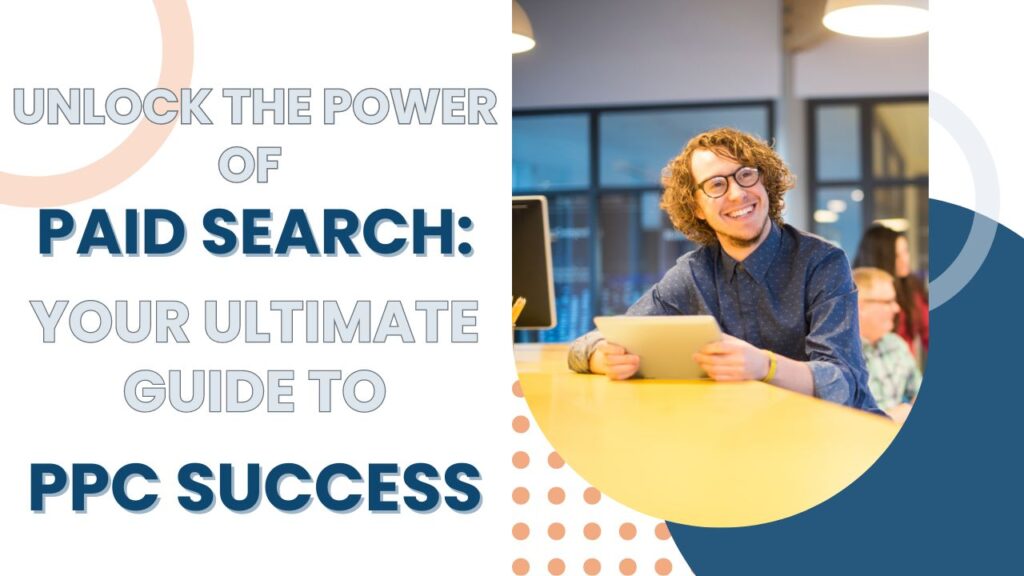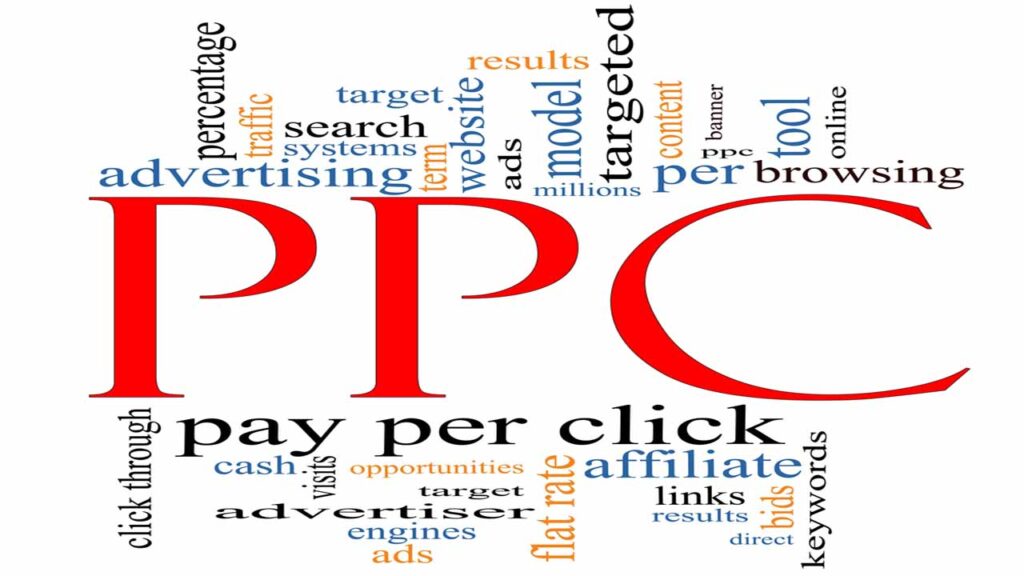What is Paid Search: A Comprehensive Guide to PPC Advertising
Brett Lewis
Paid Ads - September 16, 2024

Paid search, or Pay-Per-Click (PPC), is a digital marketing strategy where businesses pay for their ads to appear at the top of search results. This method, a crucial aspect of search engine marketing, drives targeted traffic and provides measurable results quickly. This article explains what is paid search, its key components, and its benefits.
Key Takeaways
- Paid search advertising, specifically Pay-Per-Click (PPC), allows businesses to display ads prominently in search engine results pages and only pay when users click on those ads, ensuring cost-effectiveness.
- The success of paid search campaigns is driven by targeted keyword bidding, compelling ad components such as ad headlines and descriptions, and the use of analytics for continual optimization.
- Both immediate visibility through paid search and long-term growth via SEO have their merits; a balanced strategy utilizing both can enhance overall marketing effectiveness.
What is Paid Search: A Comprehensive Guide to PPC Advertising

Paid search advertising is a digital marketing approach where companies pay to have their ads prominently displayed in search engine results. This method of online advertising, often referred to as Pay-Per-Click (PPC), involves advertisers paying a fee each time their ad is clicked by a user. The most common platforms for paid search include Google Ads and Bing Ads, which handle billions of searches daily, making them vital channels for online marketing.
One of the key benefits of paid search campaigns is the ability to target potential customers who are actively searching for specific products or services. Bidding on relevant keywords allows businesses to place their ads at the top of search results, ensuring immediate visibility and engagement.
This targeted approach not only enhances the chances of attracting high-intent users but also provides a measurable return on investment (ROI) through detailed analytics and performance tracking.
Introduction
Paid search marketing is a powerful tool that involves companies paying search engines to display their ads prominently on relevant search results pages. This strategy aims to attract traffic to their websites and convert visitors, or leads, into customers. The most prevalent form of paid search is pay-per-click (PPC) advertising, where advertisers only incur costs when users click on their ads. Search engine marketing is an essential component of this approach, often compared to search engine optimization for its immediate impact.
This form of advertising utilizes an auction model, where the position of ads is determined by bid amounts and Quality Scores. Paid search ads are designed to drive immediate traffic to landing pages, making them an effective tool for increasing visibility quickly. Understanding the mechanics of paid search enables businesses to leverage this approach to achieve their marketing goals efficiently.
Understanding Paid Search Advertising

Paid search advertising is a cornerstone of digital marketing that allows companies to pay for their ads to be displayed prominently in search engine results. The most common form of this advertising is Pay-Per-Click (PPC), where advertisers only pay when a user clicks their ad. This approach not only helps in gaining immediate visibility but also targets potential customers who are actively searching for specific products or services.
Targeted keyword bidding allows businesses to display their ads to users seeking specific solutions. Search engines like Google search, which handle over 3.5 billion searches daily, play a crucial role in this process.
Ad extensions, manual or automatic bidding strategies, and the combination of bid and Quality Score are essential components that determine the ad rank and its position on search results pages.
How Paid Search Works
Paid search operates through an auction-based system that determines the order and visibility of ads on search engine results pages (SERPs). Here’s a step-by-step breakdown of how it works:
- Advertiser Creates an Ad Campaign: The process begins with an advertiser setting up a paid search ad campaign. This involves defining a budget, selecting target keywords, and crafting compelling ad copy.
- Advertiser Sets Bid: Next, the advertiser sets a bid for each keyword, which represents the maximum amount they are willing to pay for a click on their ad.
- Search Engine Receives Search Query: When a user enters a search query into a search engine like Google, the search engine processes this request.
- Search Engine Triggers Ad Auction: The search engine then initiates an ad auction, a real-time bidding process that determines which ads will appear on the SERP and in what order.
- Advertisers’ Bids Are Evaluated: During the auction, the search engine evaluates the bids from all advertisers targeting the search query. Factors such as ad relevance, landing page quality, and bid amount are considered.
- Ad Ranking Is Determined: Based on these evaluations, the search engine determines the ad ranking. Typically, the highest bidder with the most relevant ad appears in the top position.
- Ad Is Displayed: Finally, the winning ad is displayed on the SERP, along with other relevant and high-quality ads.
This auction-based system ensures that the most relevant and well-crafted ads gain visibility, driving targeted traffic to the advertiser’s website.
Key Components of Paid Search Ads
Paid search ads are composed of several key elements that work together to capture user attention and drive engagement. These components include the ad headline, display URL, description text, and ad extensions. Each element plays a critical role in making the ad effective and ensuring it resonates with the target audience.
Ad Headlines
The ad headline is arguably the most critical component of a paid search ad. Its primary purpose is to capture attention and draw in high-intent users. Including relevant keywords in the headline can significantly enhance visibility in search results and attract users actively seeking specific solutions. Compelling ad headlines directly impact click-through rates, making them essential for successful paid search campaigns.
A well-crafted headline should be concise yet descriptive, offering a clear value proposition to the user. It’s the first thing that users see and can make the difference between a click and a scroll. By focusing on the user’s needs and incorporating powerful, action-oriented language, advertisers can create headlines that not only attract attention but also drive conversions.
Display URL
The display URL in a paid search ad serves an essential function by helping users understand where they will be taken when they click on the ad. Bing ads, for example, highlight display URLs in bold, making them visually distinct within the ad.
A clear and concise display URL guides users to the right destination, improving user experience and increasing the likelihood of a click.
Description Text
The description text in a paid search ad is a crucial component that can grab user attention and provide essential information. It should effectively showcase the key features and benefits of the product or service being advertised.
Well-crafted description text can lead to higher user engagement by capturing interest and encouraging clicks.
Ad Extensions
Ad extensions are additional features that enhance ads with extra information. These extensions can include various types of information such as location, phone number, and deep links. The primary purpose of ad extensions in paid search ads is to increase visibility and provide more information to users, thereby enhancing the overall effectiveness of the ad.
Incorporating ad extensions allows advertisers to occupy more space on the search engine results page and offer users additional ways to engage with their ads. This not only improves the ad’s visibility but also increases the chances of attracting clicks from potential customers who are looking for more information or direct ways to contact the business.
Benefits of Using Paid Search Advertising

Paid search marketing offers numerous benefits that make it an attractive option for businesses looking to enhance their online presence. From delivering immediate visibility to providing detailed analytics and precise targeting, paid search campaigns can significantly boost the effectiveness of digital marketing strategies.
Immediate Visibility
One of the standout advantages of paid search advertising is its ability to deliver immediate visibility on search engine results pages. Unlike organic SEO, which can take significant time to yield results, paid search ads can appear on SERPs as soon as the campaign begins, ensuring quick access to potential customers through platforms like Google Search. This immediate visibility is particularly beneficial for businesses looking to bypass the slow climb to the top of search engine rankings and start driving traffic to their websites right away.
Faster results than social media and SEO make paid search ads an attractive option for businesses aiming for quick visibility and measurable results. Leveraging paid search effectively boosts online presence and attracts high-intent users actively searching for products or services.
Targeted Traffic
Paid search ads excel at targeting people searching for specific solutions, focusing on audiences with high intent. This targeted approach ensures that the traffic driven to the website is more likely to convert, as these users are actively looking for the products or services being advertised. Attracting high-intent users with paid search ads results in more qualified website traffic, improved conversion rates, and a higher return on investment.
Through precise targeting based on keywords, demographics, and user behavior, paid search campaigns can connect with potential customers who are most likely to engage with the brand. This level of targeting enhances the overall effectiveness of the marketing strategy and ensures that ad spend is utilized efficiently to reach the right audience.
Detailed Analytics
One of the significant benefits of paid search campaigns is the availability of real-time analytics. These detailed insights provide valuable information about user behaviors, ad performance, and overall campaign effectiveness, allowing marketers to refine their strategies and optimize their campaigns for better results.
Cost-Effectiveness
In a PPC model, advertisers only incur costs when users click on their paid search ads, making it a cost-efficient advertising strategy. This pay-per-click approach allows businesses to control their budget tightly, deciding exactly how much to spend on each keyword and setting a maximum daily limit.
By targeting active consumers, paid search advertising ensures that ad spend is directed towards users who are most likely to convert, enhancing the overall cost-effectiveness of the campaign.
Setting Up a Successful Paid Search Campaign
Setting up a successful paid search campaign on search engines involves several crucial steps, including defining goals, conducting keyword research, creating ad groups, writing engaging ads, selecting a bid strategy, and launching the ads. Each of these steps plays a vital role in ensuring that the campaign achieves its objectives and delivers the desired results.
Regular monitoring and timely adjustments are essential to enhance the overall effectiveness of the ads and achieve a significant increase in traffic.
Keyword Research
Thorough keyword research is essential to identify the terms potential customers are searching for. Tools like Google Keyword Planner and Google Ads can be incredibly helpful in this process. By analyzing historical keyword performance, businesses can identify which terms drive the most sales and refine their focus on high-intent keywords. Regular assessment of keyword performance helps in continuously optimizing the campaign for better results.
Effective keyword research not only improves ad relevance but also ensures that the ad spend is directed towards terms that are most likely to convert. Targeting the right keywords attracts high-intent users actively searching for products or services, thereby maximizing the return on investment.
How well is your current marketing is performing? Find out with our FREE online self-assessment calculator. Click Here to get started. It only takes a few minutes, and the results are instantaneous.
Ad Groups
Organizing keywords into ad groups is essential for creating relevant and effective paid search ads. By grouping keywords based on user intent, advertisers can improve ad relevance and performance, leading to higher click-through rates and conversions.
Crafting Effective Ads
Crafting effective ads is a crucial step in setting up a successful paid search campaign. The ad headline is the first copy viewers see, featuring the largest text, which attracts high-intent searchers. Major search engines allow up to 30 characters for two headlines and 50 characters for one on Yahoo. Incorporating relevant keywords in the ad headline increases the relevance and effectiveness of the ad.
Effective ad copy should clearly communicate the value proposition to encourage user engagement. Focusing on user needs and incorporating action-oriented language helps advertisers create ads that attract attention and drive conversions. This approach ensures that the ads resonate with the target audience and achieve the desired results.
Bid Strategy
There are two main types of bid strategies available for paid search ads: manual and automated bids. Advertisers can choose between these strategies based on the desired level of control over ad spend. Before committing to a bid strategy, it’s essential to research the competition and understand the landscape.
To start bidding for ad placement on SERPs, advertisers need to set the maximum amount per click and the campaign budget.
Targeting and Location Settings
Targeting and location settings are pivotal in a paid search campaign, enabling advertisers to reach their desired audience effectively and maximize their return on investment (ROI). Here are some key targeting and location settings to consider:
- Keyword Targeting: By targeting specific keywords and phrases, advertisers can reach users actively searching for relevant content. This ensures that the ads are shown to an audience with a high intent to engage.
- Location Targeting: Advertisers can narrow their focus to specific geographic locations, such as countries, regions, cities, or even zip codes. This is particularly useful for businesses that operate in specific areas or want to target local customers.
- Language Targeting: To reach users who speak particular languages, advertisers can set language preferences. This ensures that the ads are relevant and understandable to the target audience.
- Device Targeting: Advertisers can choose to target users based on the devices they use, such as desktops, laptops, mobile phones, or tablets. This allows for tailored ad experiences that cater to different user behaviors on various devices.
- Time Targeting: By targeting specific times of day or days of the week, advertisers can reach users when they are most likely to be searching for their products or services. This can enhance ad performance and improve ROI.
These targeting options allow advertisers to fine-tune their paid search campaigns, ensuring that their ads reach the right audience at the right time and place.
Launch and Monitor
Before launching your paid ad, it’s crucial to review your search ad campaign settings, ad extensions, and URLs to ensure they align with your objectives. Launching a paid search campaign requires minimal time and effort, making it accessible for various businesses. Ads typically start showing within a couple of hours after launch, providing quick visibility in search results.
After launching, continuous monitoring of key performance metrics is essential. Closely tracking conversion rates, click-through rates, and other vital statistics allows advertisers to make informed decisions and adjust their approach as necessary. This ongoing process of testing and learning helps in refining the paid search strategy, ensuring that the campaign remains effective and profitable over time.
Comparing Paid Search and SEO

Paid search advertising yields immediate results, allowing businesses to appear at the top of search engine results pages almost instantly. In contrast, search engine optimization (SEO) can take weeks or even months to show outcomes. However, while paid search offers quick visibility, it requires continuous investment, as the advertiser pays for each click.
SEO, on the other hand, involves initial and ongoing optimization efforts, but once high rankings are achieved, organic search results clicks are free. Financially, paid search can offer an average return of $2 for every $1 spent, making it a potentially lucrative option for businesses with the budget to invest.
SEO, although it involves growing costs over time, can provide long-term benefits without the need for constant ad spend. Both strategies have their unique advantages, and a balanced approach that leverages both paid search and SEO can often yield the best results.
How Search Engines Determine Ad Rankings
Ad rankings on search engines are determined by a combination of factors, including the maximum bid, ad quality, user signals, and the competitiveness of the auction. Ad Rank, which includes these elements, plays a critical role in determining the position of ads on search engine results pages.
A high-quality ad not only ranks higher but also costs less per click, making it essential for advertisers to focus on both bid amounts and ad quality.
Bids and Budget
The ad placement on search engine results is significantly influenced by factors such as bidding, keyword relevance, and ad quality. Advertisers can adjust their bids at any time to influence ad visibility, and ad prices are generally driven by the highest bids in the competitive auction environment.
Quality Score
Search engine marketing involves various strategies, and Quality Score is a metric assigned by search engines that reflects the relevance of the ad, its expected click-through rate, and the user experience of the landing page. A higher Quality Score can lead to better ad rankings and lower costs per click, making it a crucial factor in the success of paid search campaigns.
Best Practices for Optimizing Paid Search Ads

Optimizing paid search advertising involves focusing on key outcomes such as conversions and sales. By monitoring key metrics like click-through rate, conversion rate, and average cost per click, advertisers can continuously refine their campaigns to achieve better results.
Ad extensions can further increase click-through rates, and aligning ads closely with searched terms can improve ad rankings.
Focus on High-Intent Keywords
High-intent keywords are vital in PPC advertising as they indicate strong buyer interest and help ads appear prominently on search engine results pages. Focusing on keywords that historically lead to higher sales enhances ad performance and drives more conversions. These keywords signal immediate buyer interest, making them essential for targeting users who are ready to make a purchase.
Incorporating high-intent keywords into ad campaigns helps ensure that the ads are seen by users who are most likely to convert. This targeted approach not only improves the efficiency of the ad spend but also enhances the overall effectiveness of the marketing strategy.
Use Negative Keywords
Negative keywords are used in PPC advertising to prevent ads from appearing in irrelevant search engine results, thereby increasing ad relevance. By incorporating negative keywords, advertisers can refine their targeting, avoid irrelevant searches, and enhance overall campaign effectiveness.
This approach significantly decreases unnecessary ad spend and improves the return on investment for paid search campaigns.
Optimize Landing Pages
Ensuring that landing pages are consistent with ad content through effective search engine optimization can significantly improve conversion rates. A coherent continuation of the ad’s promise on the landing page not only enhances user satisfaction but also boosts conversions.
Aligning landing pages with ad content provides a smooth user experience, leading to higher conversion rates and better overall campaign performance.
Advanced Paid Search Strategies
To optimize paid search campaigns and maximize ROI, advertisers can employ several advanced strategies. Here are some to consider:
- Ad Extensions: Utilizing ad extensions such as site links, callouts, and call extensions can provide additional information and enhance the visibility of ads. These extensions make ads more informative and engaging, increasing the likelihood of clicks.
- Retargeting: This strategy involves targeting users who have previously visited the advertiser’s website or engaged with their brand. Retargeting helps in re-engaging potential customers and encouraging them to complete desired actions.
- Dynamic Ad Targeting: By using dynamic ad targeting, advertisers can tailor their ads based on users’ search behavior and interests. This personalized approach can significantly improve ad relevance and performance.
- A/B Testing: Conducting A/B tests allows advertisers to compare different ad creatives, targeting options, and bidding strategies. This helps in identifying the most effective elements and optimizing the campaign accordingly.
- Bid Optimization: Leveraging bid optimization tools can help advertisers adjust their bids to maximize ROI. These tools analyze performance data and suggest optimal bid amounts to enhance ad visibility and efficiency.
Implementing these advanced strategies can help advertisers refine their paid search efforts, ensuring better performance and higher returns.
Common Mistakes to Avoid
Avoiding common mistakes is crucial for the success of a paid search campaign. Here are some pitfalls to watch out for:
- Poor Keyword Targeting: Targeting irrelevant or overly broad keywords can lead to wasted ad spend and poor performance. It’s essential to focus on high-intent keywords that are closely related to the products or services being advertised.
- Inadequate Ad Copy: Poorly written ad copy can result in low click-through rates and ineffective ads. Crafting compelling and relevant ad copy is vital for attracting user attention and driving engagement.
- Insufficient Budget: An inadequate budget can limit ad visibility and reduce the overall effectiveness of the campaign. It’s important to allocate sufficient funds to ensure that ads are shown to the target audience consistently.
- Inadequate Tracking and Measurement: Failing to track and measure campaign performance can hinder optimization efforts. Regularly monitoring key metrics and making data-driven adjustments is essential for improving ROI.
- Ignoring Ad Extensions: Not utilizing ad extensions can lead to missed opportunities for enhancing ad visibility and engagement. Incorporating ad extensions can provide additional information and improve the overall effectiveness of the ads.
By being aware of these common mistakes and taking steps to avoid them, advertisers can enhance the performance of their paid search campaigns and achieve better results.
Leveraging Tools for Paid Search Optimization
Various tools are available to help advertisers optimize their search engine marketing and paid search campaigns. Google Ads, for instance, provides a range of tools for ad management, performance tracking, and budget optimization. SEMrush offers a comprehensive PPC toolkit designed for planning, analyzing, and improving Google Ads campaigns. Position tracking within SEMrush enables users to monitor the performance of their paid search ads over time, providing valuable insights for continuous improvement.
AdCreative.ai is another tool that aids in creating effective ads by generating creative variations for testing. Utilizing these advanced tools allows advertisers to optimize their paid search efforts efficiently, achieve better results, and stay ahead of the competition in the dynamic world of digital marketing.
Summary
Paid search advertising is a powerful tool in the digital marketing toolkit, offering immediate visibility, targeted traffic, detailed analytics, and cost-effectiveness. By understanding the key components of paid search ads, setting up successful campaigns, and leveraging advanced tools for optimization, businesses can significantly enhance their online presence and achieve their marketing goals.
In conclusion, paid search advertising provides a strategic advantage for businesses looking to drive traffic, generate leads, and increase sales. By combining the benefits of PPC with best practices and continuous optimization, advertisers can create highly effective campaigns that deliver measurable results and a strong return on investment. Embrace the power of paid search and take your digital marketing efforts to the next level.

